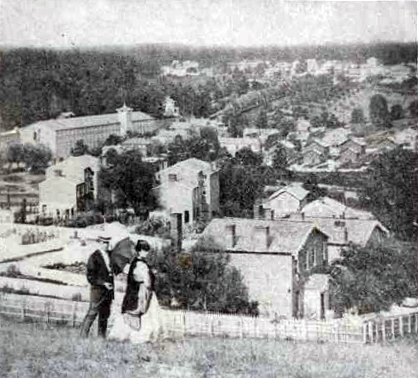
Cotton Mills of the Jones Falls

Woodberry Mill (back left) as seen from Hampden, with worker's houses in the foreground. Photo from the collection of John McGrain.
Introduction:
Historic Cotton Mills
of the Middle Jones Falls
By Deane Nettles
Special thanks to John McGrain, Baltimore industrial history expert, for his research. For more on John, see "Capturing a County's Past," Baltimore Sun, May 28, 2016.
The Hampden and Woodberry areas of Baltimore, Maryland, contain eight former cotton mills and a foundry that date from 1806 to 1904. These mills were the economic center of industry for the state of Maryland from the 1850s until the late 1880s and represent the most intact set of early industrial buildings in the U.S. outside of Lowell, Massachusetts.1
These cotton mills developed along the Jones Falls, a river that flows through Baltimore and into the Inner Harbor. River valleys in the hilly areas around Baltimore provided water power for mills and other enterprises. Their relatively gentle inclines were also natural pathways for roads and railroads. Falls Turnpike (later Falls Road), built in 1806 on the east side of the Jones Falls, was a main route for farmers from northern Maryland bringing their grain to the port of Baltimore. Grist mills quickly grew up along the Jones Falls to grind grain into flour for export, and many of these grist mills were then converted to or replaced by cotton mills when cotton duck (sail canvas) production became profitable in the 1840s and 1850s.
The Northern Central Railway (NCR), built in 1829–1830 on the west side of the Jones Falls, provided rail transportation between Woodberry and the Inner Harbor and was adopted by the mills for moving heavy raw materials — such as cotton bails and coal — and moving finished goods to markets up and down the East Coast. (The NCR rails are now used by light rail).
Though none of these are active mills and they do not contain displays of mill machinery, the mills and foundry buildings are excellent examples of both early industrial architecture and adaptive re-use. Though they were built specifically to be cotton mills, these buildings were successfully converted to other heavy and light industries and, in the past three decades, into offices, condominiums, artist studios, galleries, stores, and restaurants.
1 Richard Moe, former president (1993–2009) of the National Trust for Historic Preservation, in a speech to Baltimore Heritage c. 2003, according to Johns Hopkins, Executive Director of Baltimore Heritage (2014).